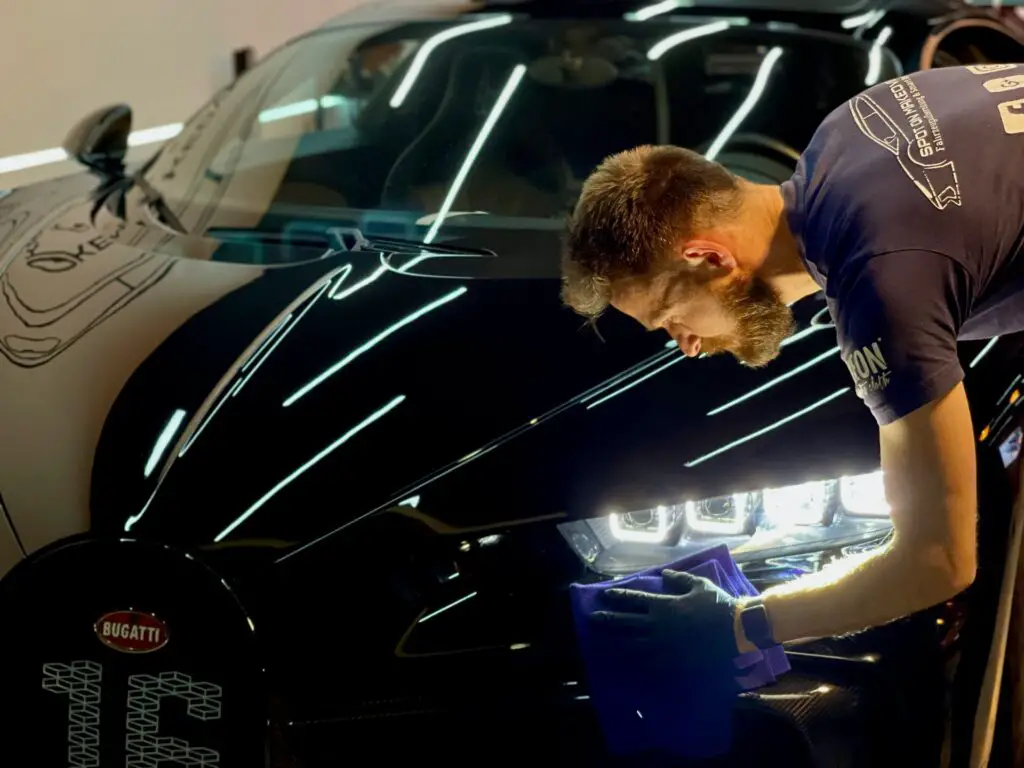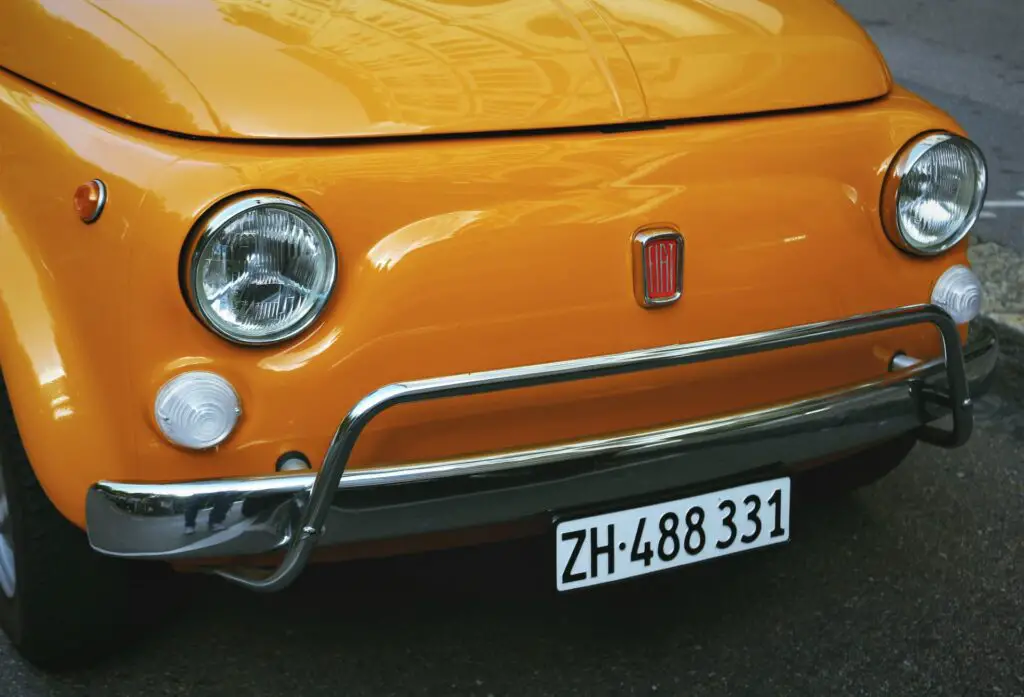Matt and dull paintwork can quickly be brought back to a high gloss with polishing. Our new article explains what to do and what to watch out for.
Structure of the car paint
Note: Only the clear coat layer is prepared during polishing. Deeper damage will not be removed.
The car paint protects the sheet metal from environmental influences, but it has to take a lot: Stone chips cause minor damage, the sun bleaches the paint, bird droppings, insect remains and tree sap attack the top layer of paint. The result: the paintwork is dull, faded, and has a matt appearance.
This can be remedied by regularly polishing the car. And polishing is nothing more than grinding in the µ range: car paint is usually 100 to 140 microns thick. Approximately 0.1 to 0.5 microns of clear coat are polished away with each polish. The paintwork then shines again, is better protected against environmental influences, and is easier to clean.
There are two ways to polish the car: by hand or by machine. However, it is not only about the polishing itself but also about the right preparation and follow-up. Our article explains the correct procedure.

Proper preparation for polishing your car
Wash the car: The first step is a thorough car wash. But even if the sheet metal dress sparkles and flashes at first glance, it still has to be subjected to special cleaning before it can be polished – by hand or by machine.
Tour around the vehicle: Despite intensive washing, there is often still a lot of dirt stuck in hard-to-reach places, so you should take a close look at the sheet metal. With the right means and the right application, this also disappears.
Apply the cleaning putty: Particularly stubborn dirt is best tackled with putty. Polishing is a good reason to repair small damage to the paintwork in advance.
Apply anti-rust: When inspecting paintwork, it is important to keep an eye on damage and take protective measures before polishing. Because if the damaged area is not treated immediately, there is a risk of corrosion. The picture gallery explains step by step how small paintwork damage is treated and how the paintwork is prepared for polishing.
Choose the right place: Do not polish in the sun. The polish dries faster here and can leave unsightly marks on the paintwork. A sheltered place, such as a garage or carport, is best for polishing the car. There is also no risk of new dirt flying onto the clean car with a gust of wind.
Mask off the plastic and rubber: Before you start polishing, all plastic parts should also be masked off carefully. Otherwise they could accidentally be polished and then appear blank or even white.
Instructions: Polishing a car by hand
Polishing by hand is particularly advisable for beginners, because you can feel better with your hand whether the pressure you are applying is correct. In addition, small corners and edges can be reached better in this way.
At the same time, polishing by hand takes a lot of time and energy. If you want to polish your whole car, you should plan several days for the work involved.
The important thing here is to work from component to component. It’s best to start with the roof and gradually work your way down. Anyone who polishes the entire car without removing the polish in between runs the risk of the polish drying out.

The required car polishing equipment
In addition to the right polishing agent, a polishing pad or sponge or special polishing cotton is required for polishing. Important: The harder the polishing sponge, the stronger the grinding effect. A microfiber cloth is also required to remove the polish.
Choosing the right polish
The stronger the polish, the greater the risk of holograms being polished into the paintwork. In case of doubt, inexperienced users prefer to opt for the weaker version and polish individual areas a little more frequently. The polish should match the paint, so with red paint it is best to choose a polish for red paint.
Depending on the condition of the paintwork, it is advisable to first sand with a coarser polish, then polish with a finer polish.
Hand polishing step by step
- Apply polishing paste to the pad, sponge or polishing cotton. If you have a pad or sponge that has not yet been used, use a little more polish at the beginning so that it is evenly distributed on the surface.
-
Distribute the polish evenly over the area to be polished (never apply the polishing paste directly to the sheet metal!).
-
Work on the paint with small circular movements under light pressure. Alternatively, the pad can be moved in a cross line. This means that the polishing pad is first moved horizontally and then vertically over the paint in small movements.
-
Over time, the polish will become translucent as the abrasive particles break down. Further polishing has no effect.
-
Remove polish residue with a polishing cloth.
-
Then degrease the surface, for example with a special isopropanol cleaner. control the result.
-
If necessary, repeat the process.

Instructions: Car polishing with the machine
Compared to polishing by hand, polishing with the machine is much faster and requires less effort. In addition, results can be achieved that are not possible with manual polishing. Dangers also lurk here, because the wrong machine or technology can quickly cause damage that can no longer be “polished away”.
The required equipment
When it comes to polishing machines, a distinction is made between eccentric and rotary machines. The eccentric polishes in elliptical movements, the rotary machine in circular ones. The eccentric is more suitable for beginners, its movement makes it easier to use and does not cause damage as quickly. The rotary machine is more powerful, but requires a professional approach. Suitable sanding pads are required for this. The harder it is, the higher the abrasive effect. And another pad for polishing.
Choosing the right polish
It is essential to use special polish for polishing with the machine. Pastes that are not suitable for machines can overheat and damage the paintwork. Some colors are also more difficult to polish than others, for example polishing a black car will cause holograms to form very quickly. They are the result if the paint is removed unevenly. The application of special anti-hologram polish is suitable here.

Machine polishing step by step
- Spray the pad with water until it is evenly moist. This way the polish is better distributed and the pad is easier to guide. And: The water cools, so paintwork damage caused by excessive frictional heat is avoided.
-
Put the polishing agent on the rotating plate. Don’t use too much polish. Three pea-sized blobs are enough.
-
Distribute the polish roughly on the surface to be polished. To do this, dab the polish onto the sheet metal with the pad and then carefully distribute it at the lowest level.
-
Guide the polishing machine in the so-called cross motion with light, even pressure over the surface – first in vertical, then in horizontal movements. In the beginning it is better to work at a low speed to get a feel for the machine – increasing the speed is always possible. Always keep the machine in motion, otherwise there is a risk that the paint will heat up in places and be damaged. Caution: With a rotary press, almost no pressure is required.
-
Polish by hand small corners and details that cannot be reached by the machine.
-
Polish the sheet metal with a special attachment (e.g. lambswool hood) at low speed. Any residue from the polish will also be removed.
-
Conserve the result and properly seal the paintwork
Tips for the best car polish
- Polishing the car is only complete with the right finish. To do this, the paint is sealed with wax, which gives it a protective layer and keeps the shine of the polish fresh for longer. A polishing sponge or cloth is needed again to work in the wax. It is again worked in circular movements, if possible without pressure.
- Always wax smaller areas bit by bit so that the wax doesn’t dry out. Polymer seals are an alternative. While waxes consist mainly of natural components such as carnauba waxes, polymer sealants are synthetically manufactured. They should last longer and be more resistant than classic hard wax because they form a chemical bond with the paintwork while the wax just “lies on it”. On the other hand, sealing with wax achieves a higher degree of gloss than sealing with synthetic agents.
FAQ about polishing your car
How often should you polish your car?
Since a tiny layer of paint is always removed during polishing, the car should not be polished too often. As a rule, it is completely sufficient to give the paintwork a polish once a year. Better a little less often than more often. Instead, it is better to use a good wax more often: This maintains the shine and protects the color. Important: Before waxing, be sure to wash the car well.
When is the right time to polish?
The perfect time to polish the car is with the beginning of spring. Then the temperatures are still moderate and the paintwork gets proper care after the strenuous, cold season. But autumn is also suitable for polishing to give the car another protective layer before winter. It is important that the polishing is not carried out in the blazing sun, because the polishing agent dries up too quickly here.
How much does a car polish cost in a specialist workshop?
If you don’t want to do the work yourself, you can have your car polished in a specialist workshop. The price for this depends on several factors, for example the size of the car, but also the condition of the paintwork. For a professional who works with good equipment and resources, the price for a polish is usually between $200 and $300. It is best to get several offers beforehand, because there are often clear differences. In independent workshops you sometimes pay less than with a professional detailer. It is also worthwhile to find out about possible savings offers.

